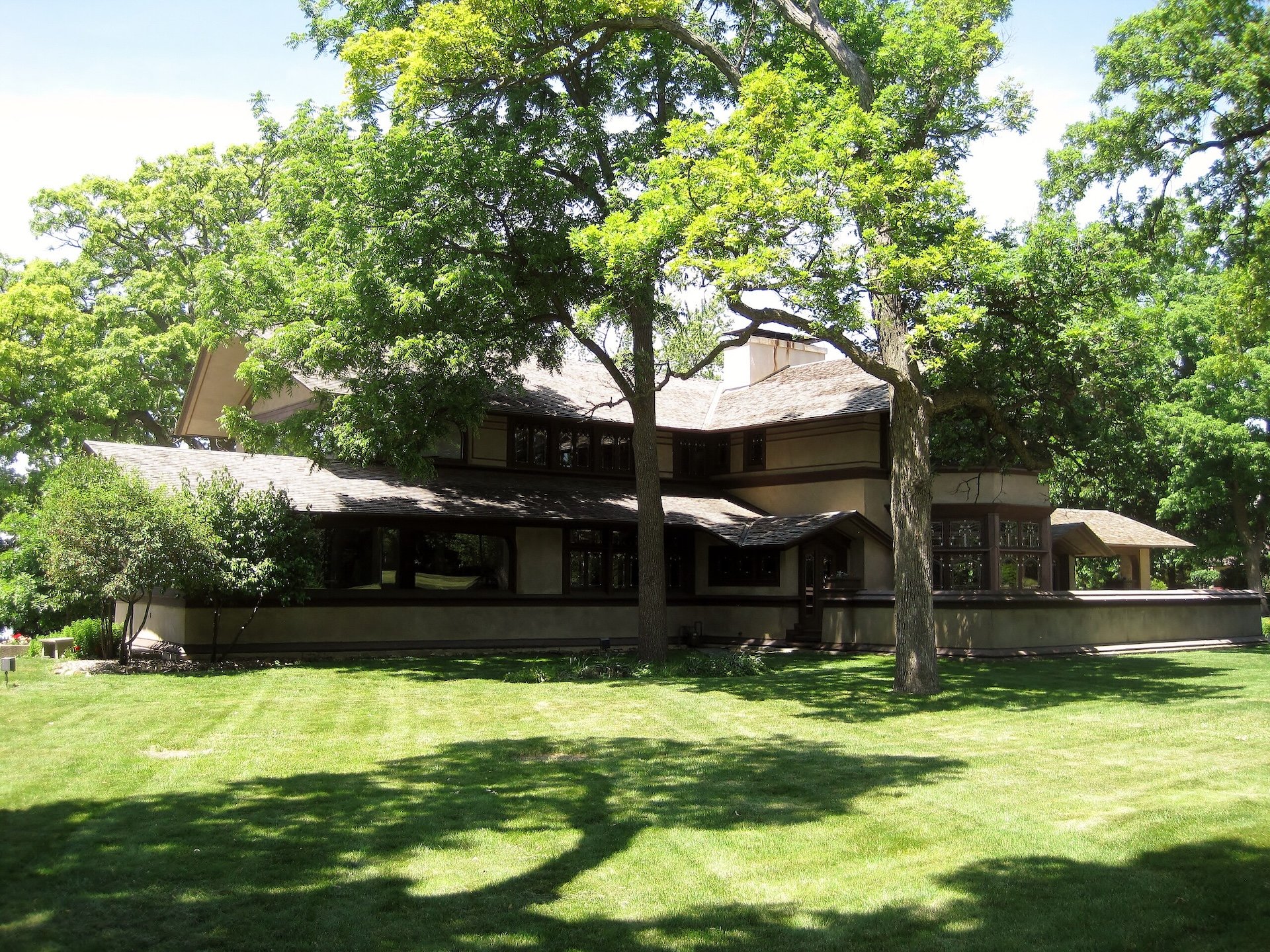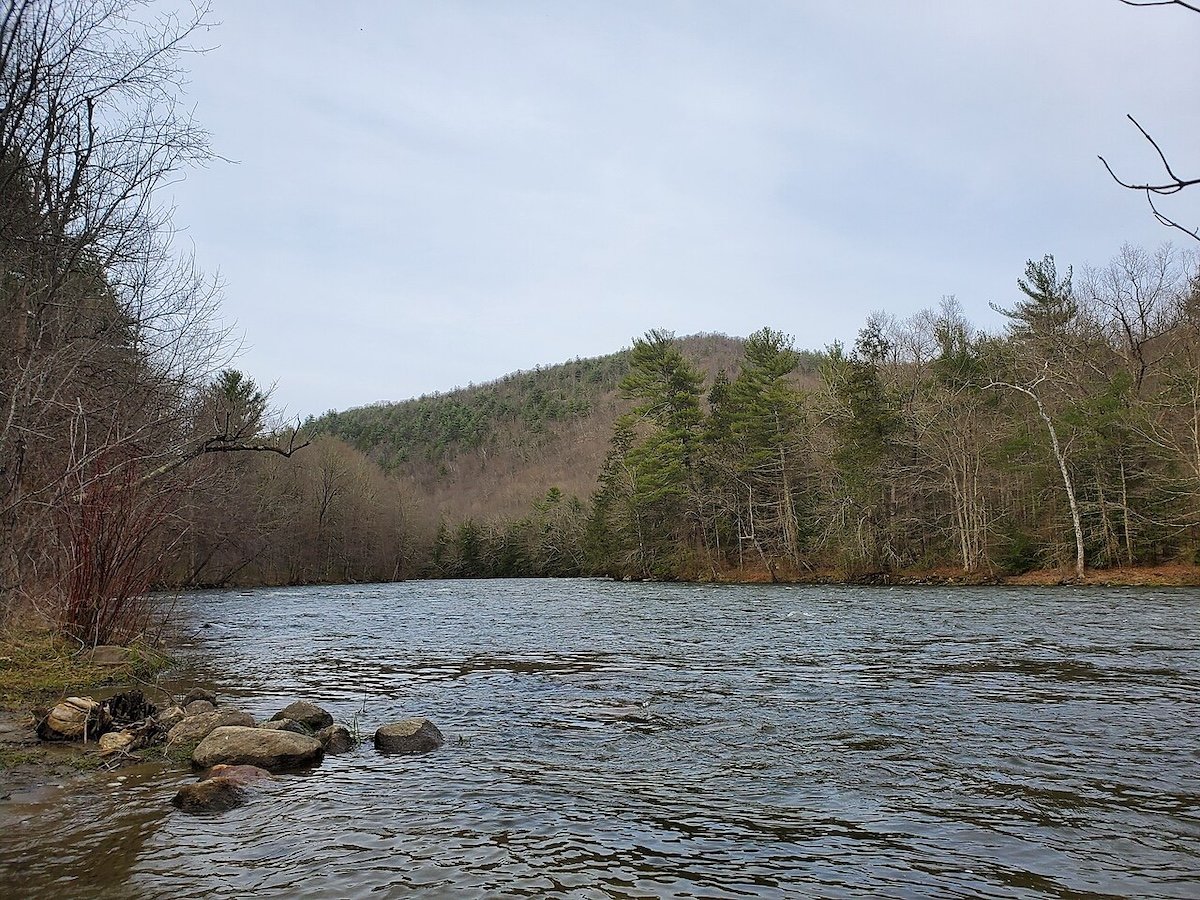
New York’s story is written far beyond the lights of Manhattan. Scattered from the Adirondacks to the Niagara Frontier, small towns guard centuries-old architecture, battlefields, and legends that shaped the nation.
Each stop offers more than a quick photograph; these communities invite lingering walks, museum conversations, and perhaps an unexpected festival or hiking trail. By counting down through sixteen distinctive places, we celebrate the people and landscapes that keep New York’s past very much alive.
16. Lewiston: A Gateway of Historical Significance

Lewiston sits on a bluff above the Niagara River, and its quiet streets once bustled with freedom seekers traveling the Underground Railroad. Visitors can tour the modest stone building known as the Frontier House, share stories with re-enactors at the Lewiston Museum, and catch outdoor concerts at Artpark.
We enjoy strolling Center Street, where brick storefronts host farm-to-table cafés and shops filled with locally blown glass. Each September, the town stages one of the region’s oldest festivals, the Peach Festival, pairing carnival rides with a pie-eating contest that dates back decades.
For paddlers, the launch at Lewiston Landing allows easy access to the lower Niagara gorge, a section few tourists ever see. The average price for a 3-4 bedroom home in Lewiston ranges from $300,000 to $450,000, offering options for those seeking historic charm.
Where is Lewiston?
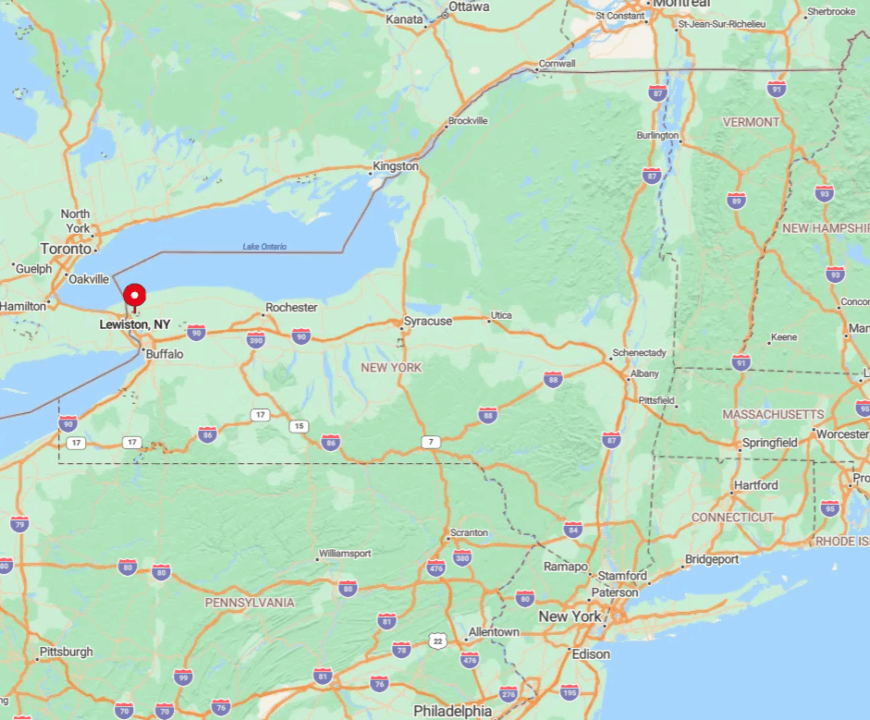
The village lies in western Niagara County, seven miles north of Niagara Falls and minutes from the Canadian border. High riverbanks provide sweeping views toward Ontario, while the Niagara Escarpment rises gently to the east, supplying excellent vineyard terrain.
Drivers reach Lewiston via the Niagara Scenic Parkway or Interstate 190, then follow signs for Center Street. Buffalo Niagara International Airport is forty minutes away, and a seasonal ferry links the village with Youngstown for cyclists tracing the waterfront trail.
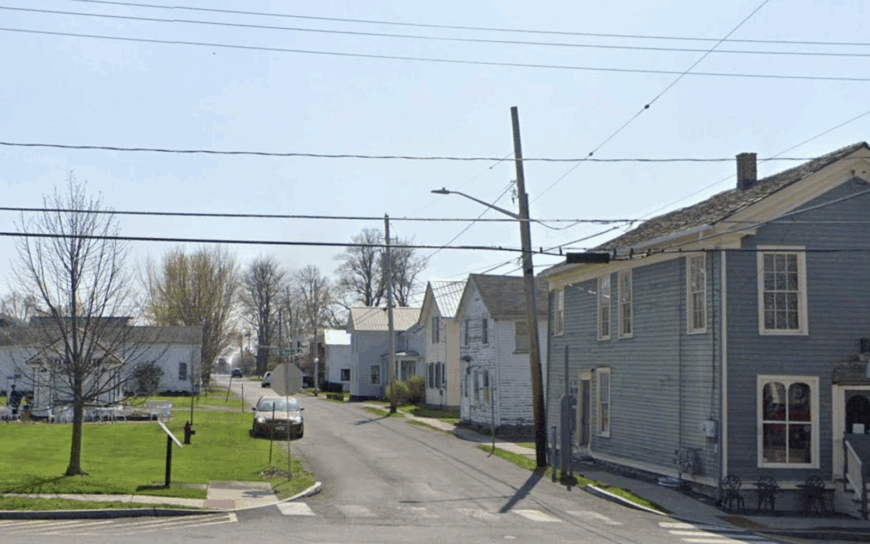
Sackets Harbor earned fame during the War of 1812, when shipbuilders raced to dominate Lake Ontario and the U.S. Navy established a vital yard along these sheltered waters.
Today, the battlefield remains intact, with loop paths weaving past earthworks and interpretive panels that describe cannon fire once echoing across the bay. Along Main Street, limestone buildings house bakeries serving maple-glazed doughnuts and pubs pouring craft beer named after historic vessels.
Boaters appreciate the deep natural harbor, while landlubbers kayak the marshes of neighboring Horse Island, newly opened to the public. A favorite hidden gem is the Pickering-Beach Museum, where period-dressed guides demonstrate 19th-century cooking beside an open hearth.
Summer evenings often end with waterfront sunsets watched from the wooden benches behind the municipal dock. In Sackets Harbor, 3-4 bedroom homes typically cost between $250,000 and $400,000, reflecting its rich history and welcoming community.
Where is Sackets Harbor?
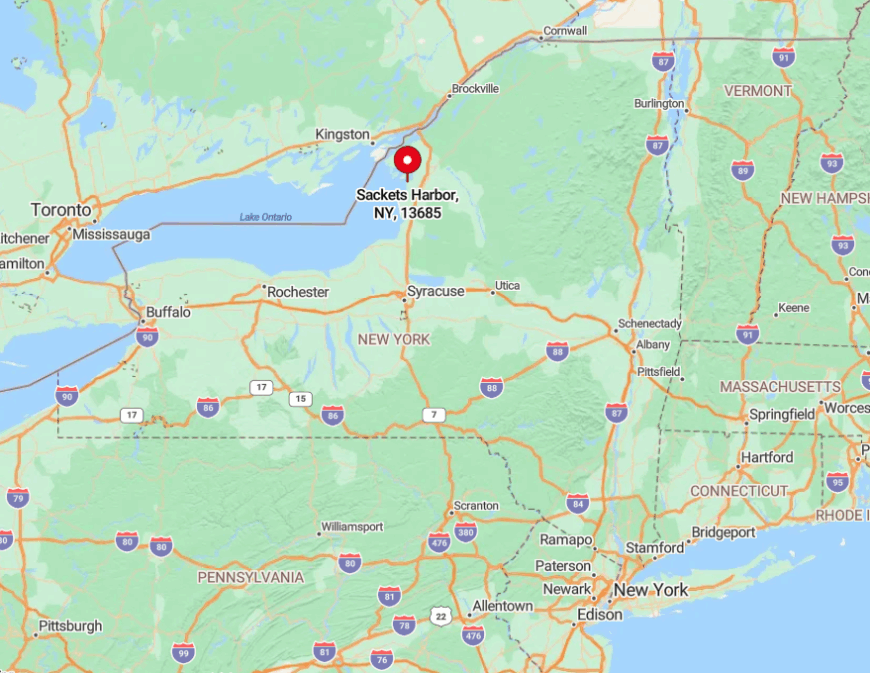
The village occupies a small peninsula on Lake Ontario, roughly ten miles southwest of Watertown in northern New York. Its position at the mouth of Black River Bay offered perfect protection for wartime shipyards and continues to draw sailors seeking calm anchorage.
Travelers typically exit Interstate 81 at Route 3, then follow shoreline roads through farmland before reaching the harbor’s clustered masts. Regional flights land at Watertown International Airport, and cyclists on the Seaway Trail treat the town as a welcome layover.
14. Chautauqua: A Historic Learning Community
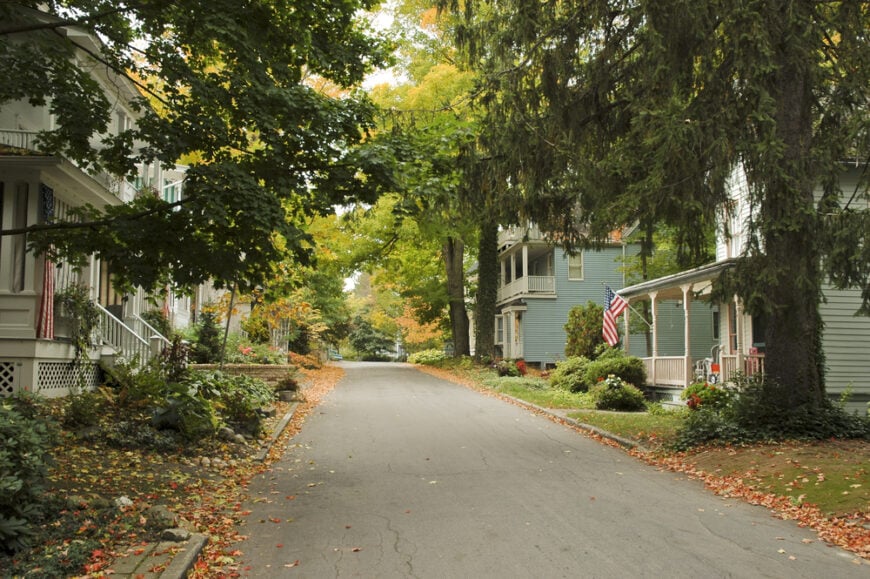
Founded in 1874 as an experiment in adult education, Chautauqua quickly evolved into a Victorian lakefront campus where philosophy lectures mix with chamber music and watercolor classes.
Gingerbread cottages painted in sherbet hues line shaded lanes, their wide porches filled with rocking chairs and lively conversation throughout summer. The Amphitheater still hosts morning sermons and evening symphonies under a soaring timber roof that resonates with more than a century of dialogue.
Day visitors can purchase a gate pass, join a yoga session on Bestor Plaza, and browse the bookstore that once supplied Theodore Roosevelt. We recommend renting a canoe to explore hidden coves on Chautauqua Lake, where great blue herons patrol silent reed beds.
Off-season, the grounds grow quiet, perfect for reflective walks among fallen leaves and lake-fog mornings. Chautauqua features 3-4 bedroom homes priced between $250,000 and $400,000, making it an affordable choice for those drawn to its cultural heritage.
Where is Chautauqua?
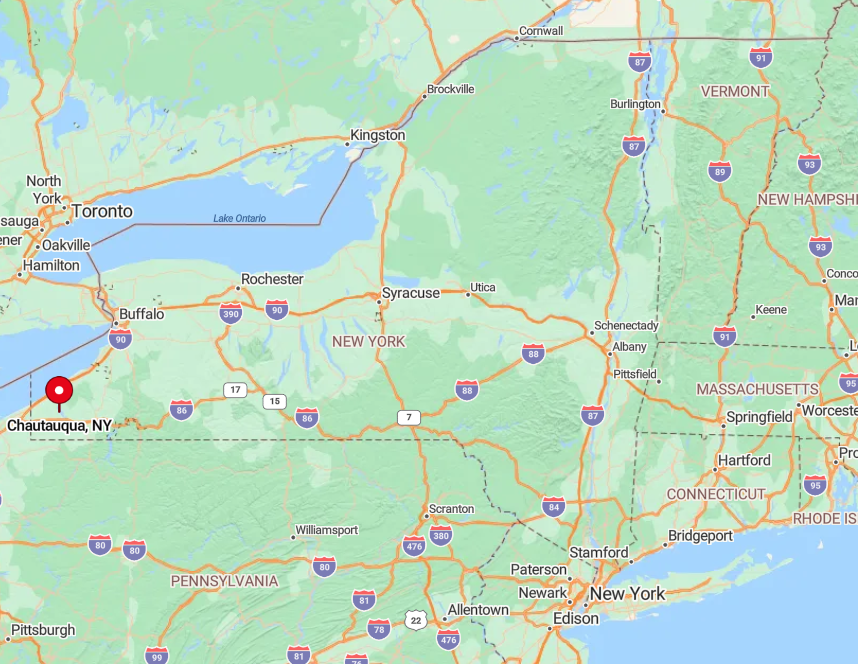
The institution sits on the western shore of Chautauqua Lake, midway between Erie, Pennsylvania, and Buffalo. Rolling vineyards and Amish farms surround the water, giving the area a pastoral feeling distinct from New York’s urban corridors.
Motorists follow Interstate 86 to Exit 60, then wind north on Route 394 until the landmark Miller Bell Tower comes into view. Jamestown’s small airport offers flights from Pittsburgh, and a seasonal ferry crosses the lake from Bemus Point for those arriving by bicycle.
13. Tarrytown: Historic Estates and Legends
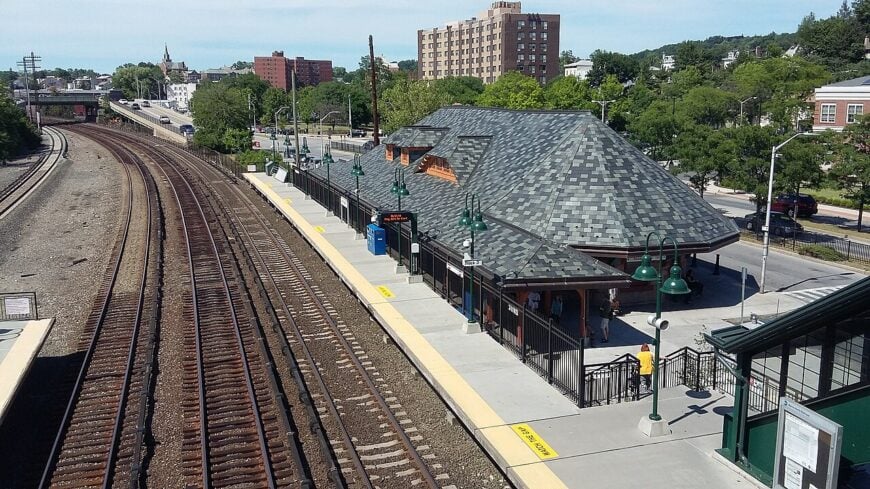
Tarrytown thrives on layers of Gilded Age wealth and colonial folklore shared with its neighbor, Sleepy Hollow. Lyndhurst Mansion, an 1838 Gothic Revival masterpiece, opens art-filled rooms and landscaped paths overlooking the Hudson, while nearby Kykuit showcases Rockefeller family treasures.
The village center hosts the Tarrytown Music Hall, one of the oldest theaters in the state, where indie bands share the marquee with silent-film screenings accompanied by live organ.
Shoppers browse bookstores and French patisseries along Broadway before venturing down to Scenic Hudson RiverWalk Park for sunset over the Palisades. A lesser-known delight is the Old Croton Aqueduct Trail, which slips quietly behind backyards beneath a canopy of tulip trees and oaks.
Each October, lantern tours and seasonal markets connect residents with centuries of storied river life. 3-4 bedroom homes in Tarrytown range from $600,000 to $900,000, appealing to buyers interested in historic elegance.
Where is Tarrytown?
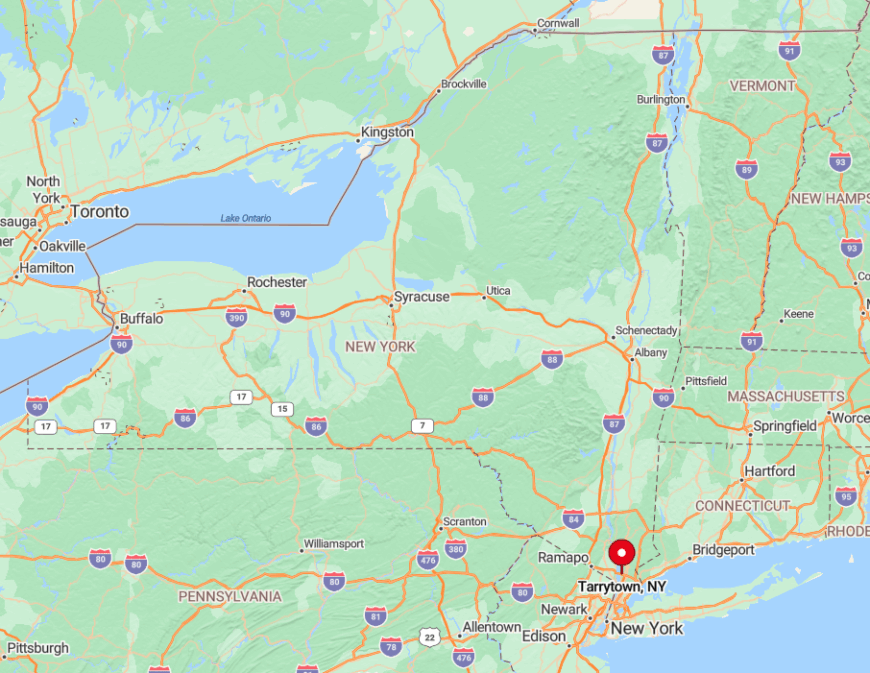
Perched on the eastern bank of the Hudson River in Westchester County, Tarrytown enjoys quick train access to midtown Manhattan while feeling worlds removed. Steep hills give way to waterfront parks, and the Mario M. Cuomo Bridge arcs in the distance, symbolizing the region’s long transportation history.
Travelers can ride Metro-North’s Hudson Line directly into the village or drive the Taconic Parkway and Route 119. Cyclists often approach via the bridge’s shared-use path, rewarded with sweeping river panoramas as they roll into town.
12. Seneca Falls: Birthplace of Women’s Rights
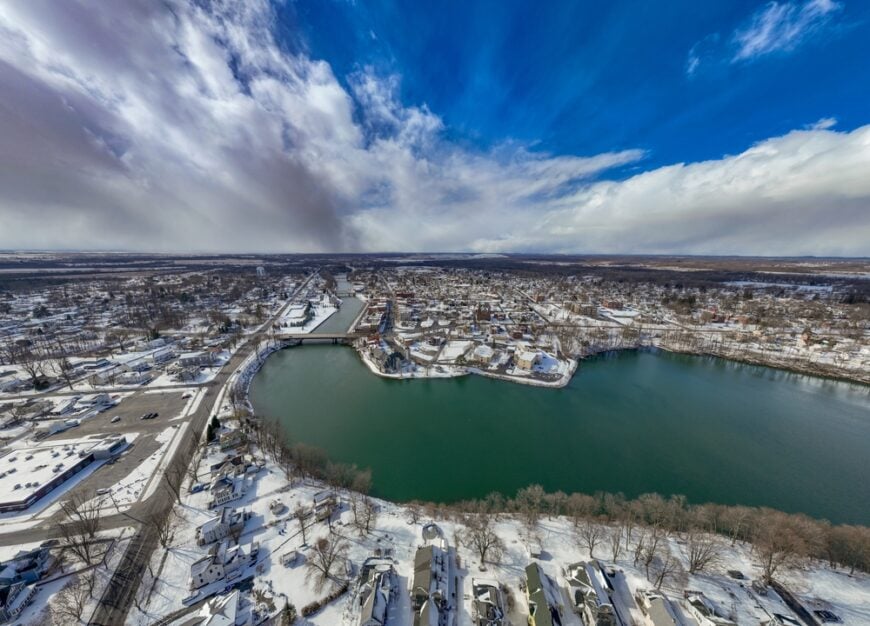
In July 1848, reformers gathered in Seneca Falls’ Wesleyan Chapel to sign the Declaration of Sentiments, launching the fight for women’s suffrage. Today, that brick building anchors Women’s Rights National Historical Park, where rangers talk and exhibits place visitors amid the debates that reshaped American democracy.
Across the canal lies the National Women’s Hall of Fame, recently moved into a restored knitting mill filled with portraits of inductees ranging from Sojourner Truth to Sally Ride.
The downtown district retains Italianate storefronts now housing cafés, a fiber-arts cooperative, and the “It’s A Wonderful Life” Museum, celebrating the town said to inspire Bedford Falls in Frank Capra’s film.
We especially enjoy the Canal Fest each July, when live music floats above food trucks serving everything from pierogi to grape-pie ice cream. Seneca Falls offers 3-4 bedroom homes between $200,000 and $350,000, providing affordable options in this iconic town.
Where is Seneca Falls?

Seneca Falls rests at the northern end of Cayuga Lake, midway between Rochester and Syracuse in the heart of the Finger Lakes. The town straddles the Cayuga-Seneca Canal, a vital link to the Erie Canal system that once carried reformers and goods alike.
Drivers exit the New York State Thruway at Exit 41 and follow Route 414 south for five miles to reach the historic core. Regional buses stop on Fall Street, and cyclists enjoy the Erie Canalway Trail segment that skirts the village’s northern edge.
11. Aurora: A Quaint Village on Cayuga Lake
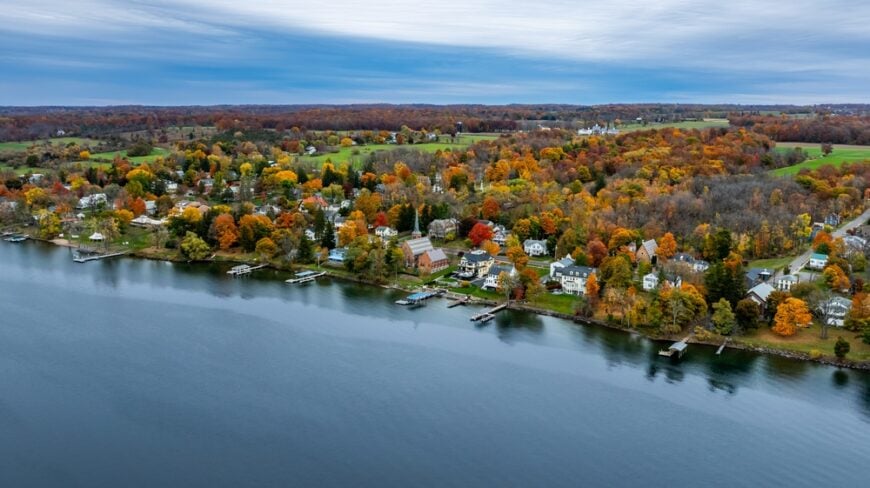
Aurora’s entire lakeside Main Street feels like a period film set, anchored by Wells College’s Gothic Revival stone halls and the Aurora Inn, where carriage steps still greet horse-drawn wedding parties.
Residents preserve lake views by trimming hedgerows rather than fencing them, giving passersby uninterrupted vistas over glimmering Cayuga waters. You might delight in visiting the Mackenzie-Childs farm, a whimsical ceramics producer whose open grounds feature Scottish Highland cattle and a storybook-style cottage.
Small tasting rooms pour Riesling from nearby vineyards, and the village dock becomes a gathering place for sunset swimmers and anglers hoping for lake trout. The Morgan Opera House hosts folk concerts that spill onto the lawn during intermission.
Autumn brings migrating waterfowl and quiet streets perfect for sketching historic facades. Aurora features 3-4 bedroom homes priced between $350,000 and $550,000, combining affordability with historic allure.
Where is Aurora?
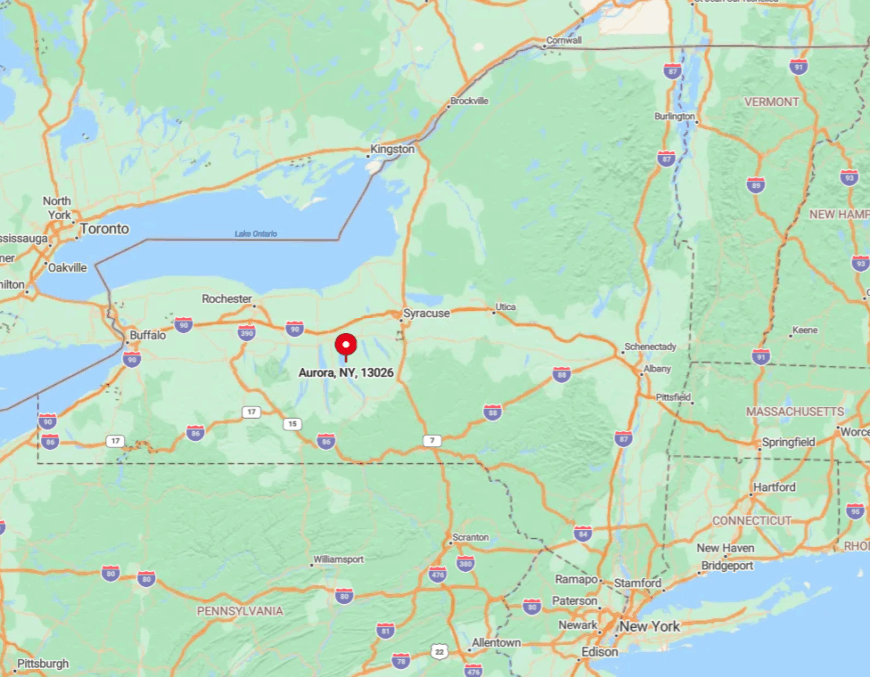
The village occupies a narrow strip on Cayuga Lake’s eastern shore, roughly 35 minutes north of Ithaca and 20 minutes south of Auburn. Rolling hills rise behind the town, dotted with orchards that scent the air with blossoms each spring.
Drivers reach Aurora via Route 90, a scenic byway skirting stone-walled farms and timber barns. Limited regional buses connect through Ithaca, but most visitors prefer the leisurely drive, stopping at roadside farm stands along the way.
10. Cold Spring: 19th-Century Riverside Village
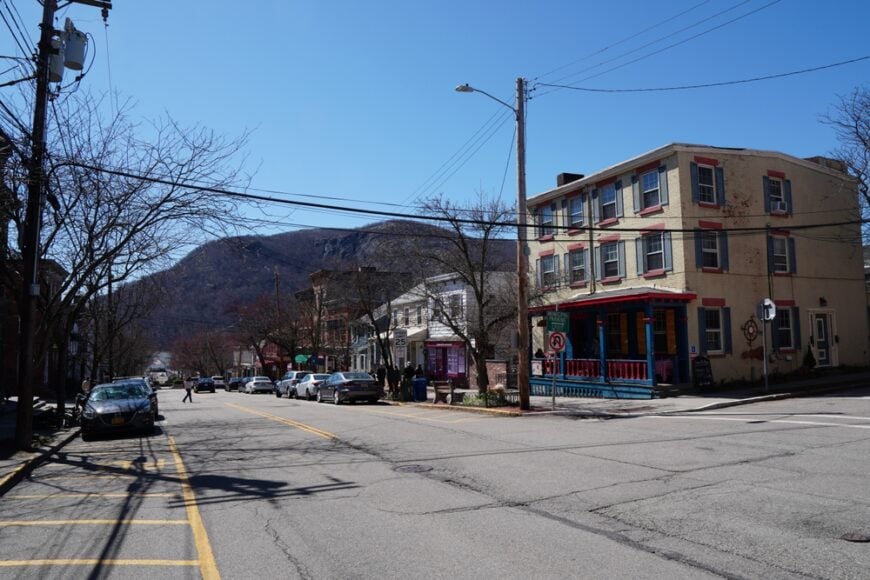
Cold Spring retains the look of a Civil War-era postcard, its compact Main Street lined with clapboard homes, iron balconies, and centuries-old inns once frequented by foundry workers from the nearby West Point Foundry.
Antique stores mix with coffee roasters, and weekend farmers markets set up beside the 1868 bandstand overlooking the Hudson. Outdoor enthusiasts tackle Breakneck Ridge or Bull Hill trails, while history buffs explore the Foundry Preserve, where interpretive signs describe steam engines cast for Union warships.
Kayak rentals launch from Dockside Park, letting paddlers drift past Constitution Island and the soaring walls of Storm King Mountain. Our secret favorite is Magazzino Italian Art, a modern museum just outside the village featuring contemporary works tucked into a reclaimed warehouse.
Evenings often end with ice cream cones enjoyed on riverside benches as Metro-North trains glide quietly past. Cold Spring has 3-4 bedroom homes ranging from $600,000 to $900,000, ideal for those seeking a blend of history and scenic beauty.
Where is Cold Spring?
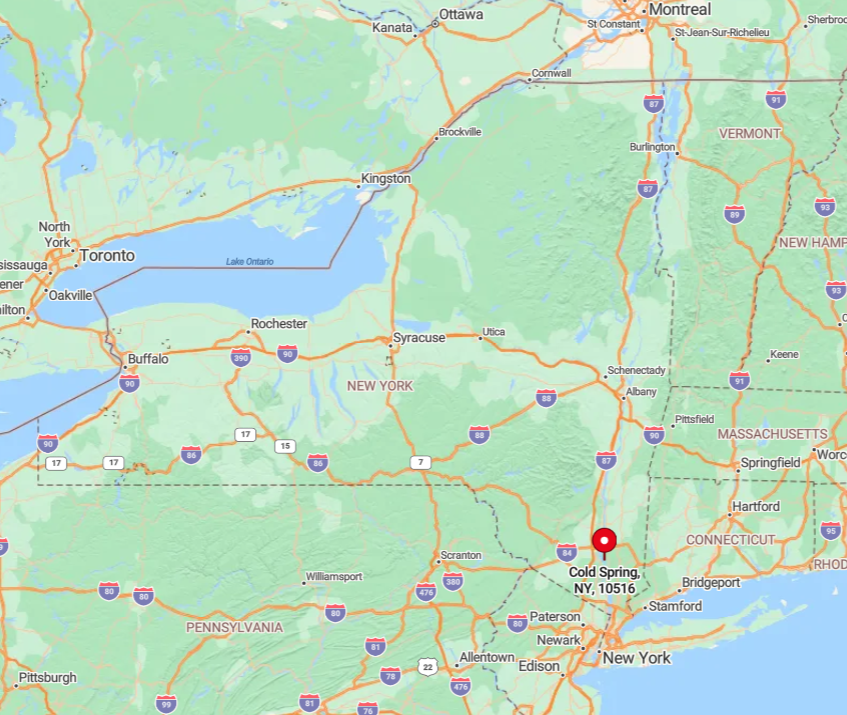
Situated in Putnam County, about 50 miles north of New York City, Cold Spring hugs a narrow flat along the Hudson beneath forested highlands. The river’s sharp bend here once protected colonial shipping and now frames dramatic sunset reflections.
Commuters and day-trippers appreciate the Metro-North Hudson Line station steps from Main Street, while motorists arrive via Route 9D after a scenic drive over the Bear Mountain Bridge. A seasonal trolley connects trailheads and nearby Boscobel House, easing car-free exploration.
9. Woodstock: Iconic Arts and Culture

Long before its name graced a legendary 1969 festival held miles away, Woodstock nurtured painters, potters, and free-thinkers drawn to Catskill light and rugged peaks.
The Byrdcliffe Guild, founded in 1902, still offers workshops in weaving, ceramics, and printmaking amid forested studios that once hosted Hudson River School artists.
Tinker Street’s galleries showcase local talents alongside vintage record shops and cafés where folk musicians strum on unamplified guitars. Maverick Concert Hall, a rustic wooden structure in the woods, claims to be the nation’s oldest continuously running summer music festival, hosting string quartets beneath star-filled skies.
Hikers ascend Overlook Mountain past abandoned hotel ruins to a fire tower with views of the Ashokan Reservoir. Each fall, the Woodstock Film Festival transforms storefronts into screening rooms, affirming the town’s enduring creative pulse.
Woodstock offers 3-4 bedroom homes priced between $500,000 and $800,000, appealing to those who value artistic and historic communities.
Where is Woodstock?
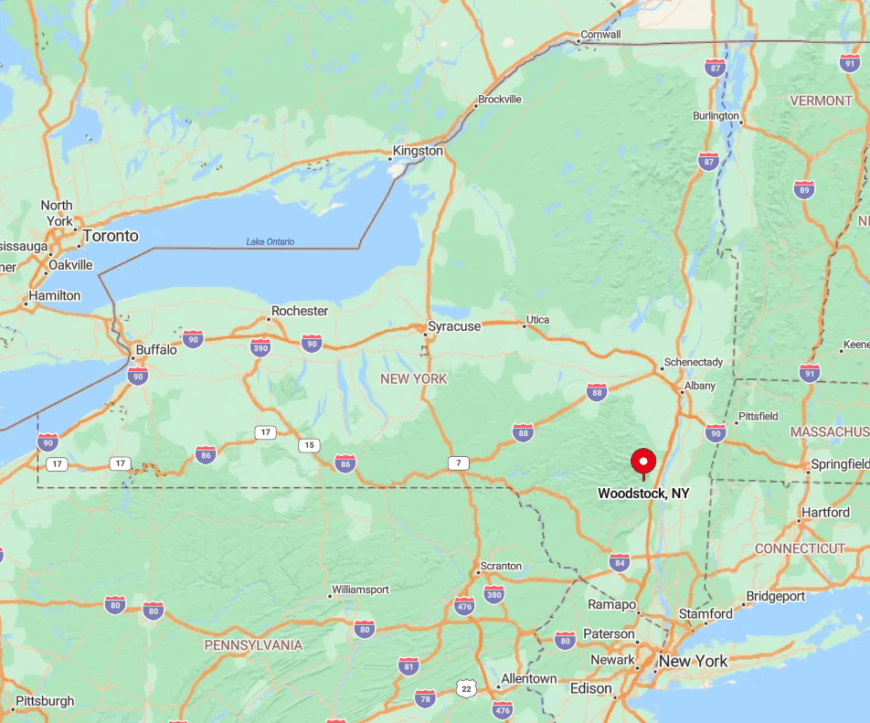
The village nestles at the base of the Catskill High Peaks in Ulster County, about 15 minutes west of the Hudson River. Curving Route 212 delivers drivers from Exit 19 of the New York State Thruway through forested valleys punctuated by farm stands.
Trailways buses run regularly from the Port Authority in Manhattan, dropping visitors near the Village Green. The location provides quick access to both rippling mountain creeks and cultural day-trips to Kingston’s historic waterfront.
8. Lake Placid: Olympic Legacy and Adirondack Charm
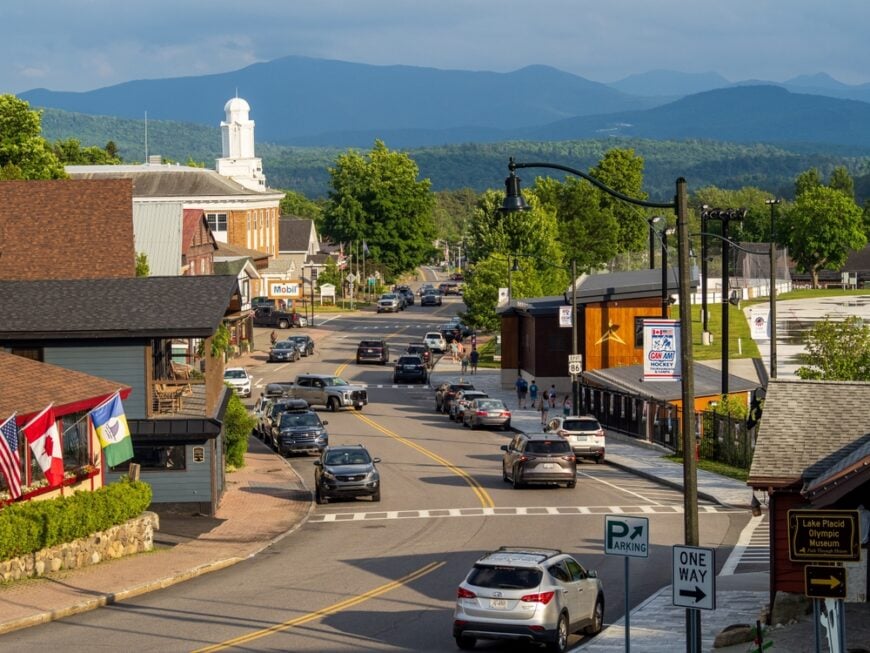
Lake Placid twice welcomed the world for the Winter Games, and echoes of 1932 and 1980 still ring from the ice at the Olympic Center where a scrappy American hockey team upset the Soviets.
Travelers ride a glass elevator up the ski-jump tower for a bird’s-eye view of the High Peaks, then speed down the bobsled track with a professional driver even in summer.
The village itself blends Adirondack Great Camp architecture with outdoor outfitters and maple-creemee stands along Main Street circling Mirror Lake. Paddlers glide across the lake in cedar strip canoes, while hikers tackle nearby Mount Jo for a family-friendly summit panorama.
History hides in plain sight on the Brewster Peninsula Trails, where signs describe early 20th-century life amid hemlocks. Evening brings fire pits along the shore and perhaps a ghost story about the hotels that once towered over these woods.
The average price for a 3-4 bedroom home in Lake Placid ranges from $400,000 to $650,000, blending mountain charm with historical significance.
Where is Lake Placid?
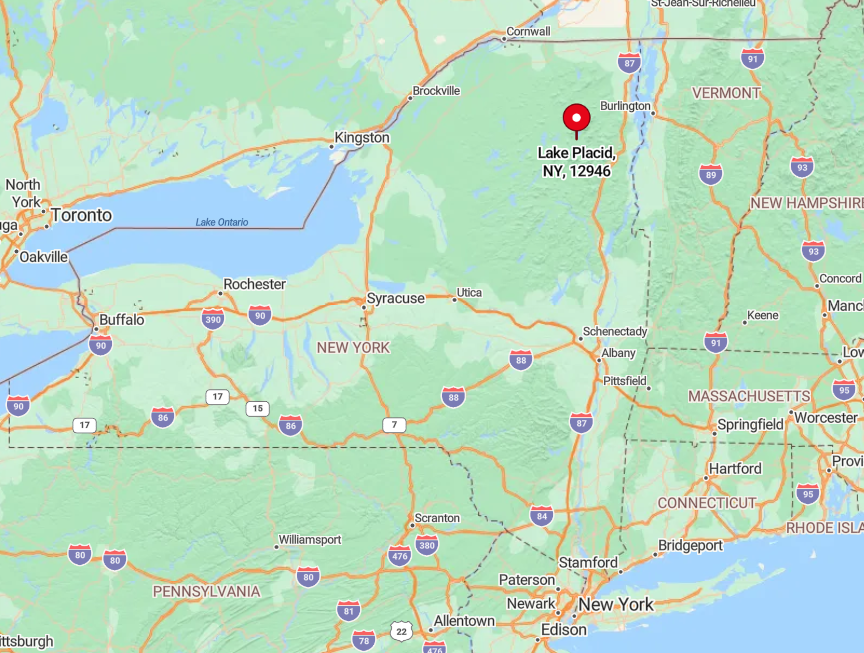
The village lies deep within the Adirondack Mountains, about 50 miles southwest of the Canadian border and surrounded by protected wilderness. Route 73 winds north from the Adirondack Northway (I-87) past waterfalls and granite cliffs before dropping into the valley holding Lake Placid and Mirror Lake.
Adirondack Regional Airport in Saranac Lake offers daily flights from Boston, and the seasonal Adirondack Railroad brings rail enthusiasts from Utica. Its remote setting, encircled by high peaks, underscores both the challenge and beauty embraced by early Olympic planners.
7. Skaneateles: Lakeside Beauty and History
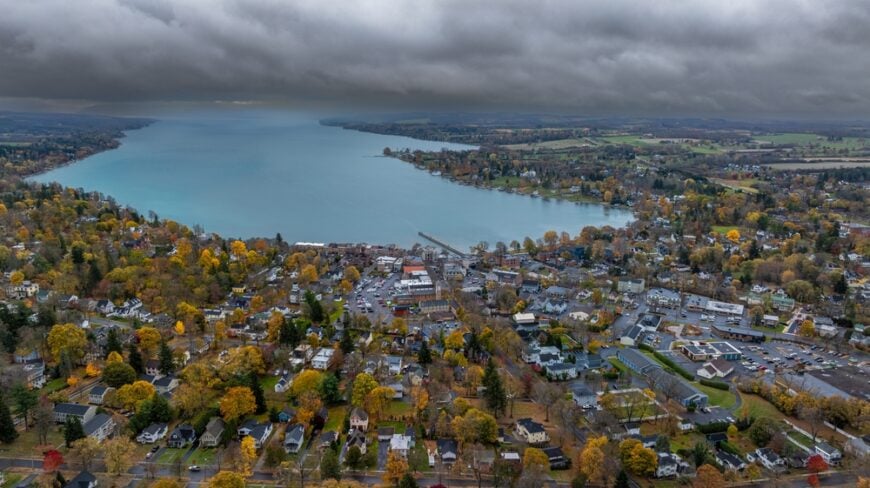
Pronounced “skin-ee-AT-uh-liss,” this village hugs the northern tip of Skaneateles Lake, whose crystal-clear waters famously supply Syracuse’s unfiltered drinking water. Greek Revival storefronts host boutiques and farm-sourced restaurants, while the 1871 gazebo in Clift Park frames weekly summer band concerts.
We recommend stepping aboard the vintage launch Judge Ben Wiles for narrated cruises past 19th-century summer estates hidden among cedars. Anyela’s Vineyards pours cold-climate reds on a hillside overlooking the blue-green lake, and Dickens Christmas weekends feature costumed carolers wandering snow-dusted sidewalks.
Local lore holds that President Roosevelt once swam here and declared the water “purer than whisky.” Anglers cast for lake trout from the municipal pier at dawn, when mist curls above the glassy surface.
Skaneateles features 3-4 bedroom homes priced between $550,000 and $850,000, perfect for buyers seeking lakeside history and luxury.
Where is Skaneateles?
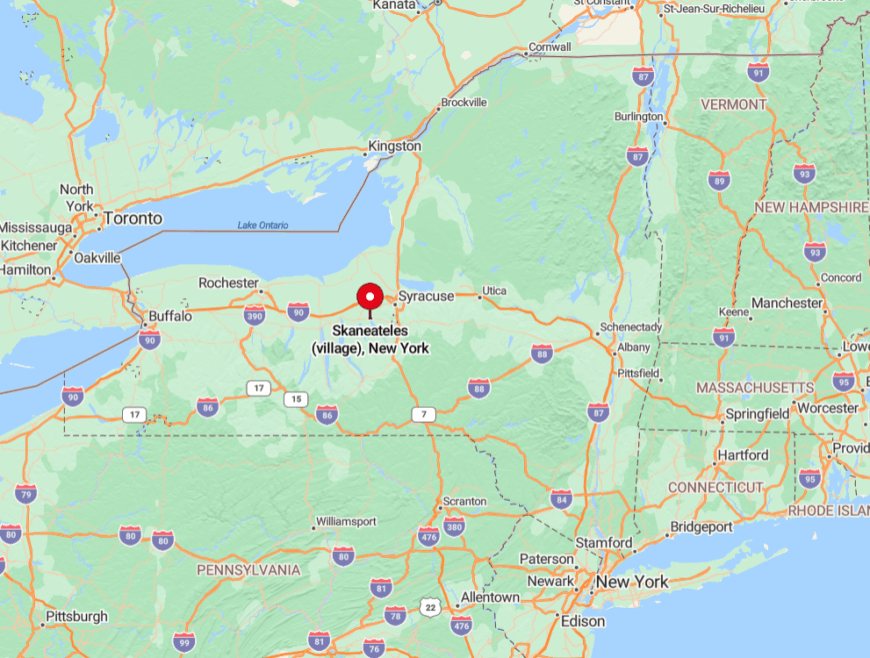
The village sits in the eastern Finger Lakes, roughly 20 miles southwest of Syracuse along U.S. Route 20. Glacial hills encircle the long, narrow lake, creating dramatic vistas and steep vineyard slopes.
Drivers arriving from the New York State Thruway exit at Weedsport and enjoy a pastoral ten-mile ride past dairy farms. Syracuse Hancock International Airport provides the closest commercial flights, and a regional bus drops passengers on Genesee Street near the lakefront gazebo.
6. Beacon: Artistic Heritage in an Industrial Setting
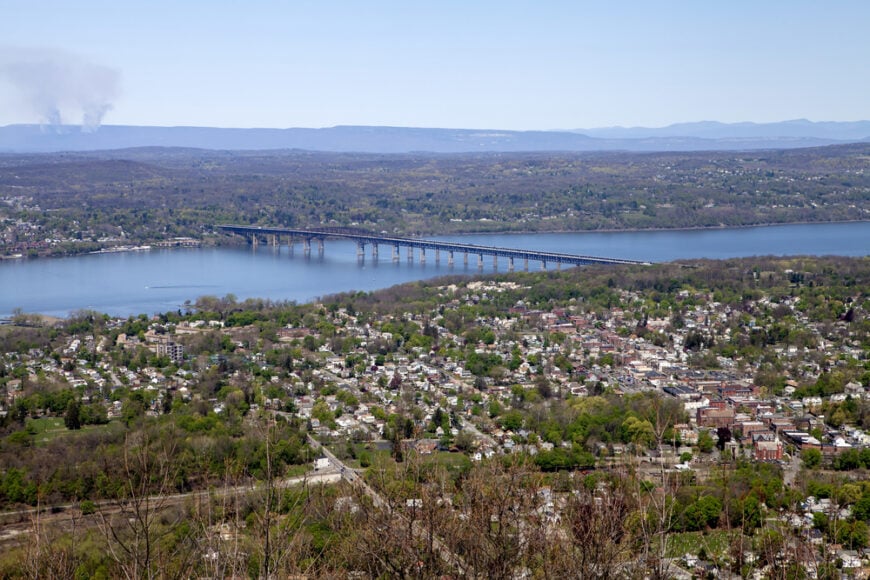
Beacon transformed abandoned hat factories and brick warehouses into one of the Hudson Valley’s most vibrant arts hubs, anchored by Dia: Beacon, a sprawling contemporary museum housed in a former Nabisco box-printing plant.
Main Street stretches for a mile, dotted with indie bookstores, vinyl shops, and micro-roasters that roast beans on-site in vintage Probat machines. Hikers test their calves on Mount Beacon’s staircase-like trail to the old incline-railway ruins and a fire tower offering river panoramas all the way to Manhattan on clear days.
The 1709 Madam Brett Homestead, the valley’s oldest house, welcomes visitors with period gardens and stories of early Dutch settlers. Beacon Riverfront Park hosts free concerts against sunsets reflecting off low-lying fog skimming the Hudson.
Our insider tip: seek out Second Saturday evenings when galleries coordinate openings and food trucks form an impromptu street fair. Beacon offers 3-4 bedroom homes ranging from $450,000 to $700,000, reflecting its reputation as a vibrant historic town.
Where is Beacon?

Beacon occupies the eastern shore of the Hudson, roughly 60 miles north of New York City, framed by Fishkill Ridge to the east and the Newburgh-Beacon Bridge to the south. Metro-North’s Hudson Line delivers passengers directly to the riverfront, and Interstate 84 provides quick car access from both Connecticut and New Jersey.
The city’s compact layout encourages walking, with a free shuttle linking the train station, Dia, and the Mount Beacon trailhead. Water-taxi service to Newburgh operates in summer, adding a breezy alternative for cross-river exploration.
5. Rhinebeck: Colonial Roots and Charm

Originally settled by Dutch traders, Rhinebeck layers colonial stone houses alongside 19th-century mansions shaded by ancient maples lining Market Street. The Beekman Arms, said to be America’s oldest continuously operating inn, has hosted everyone from George Washington to Chelsea Clinton’s wedding guests.
Aviation lovers flock to Old Rhinebeck Aerodrome, where early-aviation biplanes roar overhead in costumed weekend airshows, while bookworms explore Oblong Books for local-history titles.
The Dutchess County Fair, each August, transforms the fairgrounds into a countywide reunion of farmers, artisans, and carnival lights. Our preferred quiet corner is Ferncliff Forest, with a steel fire tower granting sweeping Hudson Valley vistas for the price of a short woodland walk.
Shoppers discover hand-woven Mohair throws at Winter Sun & Summer Moon before lingering over farm-sourced meals at the historic tavern. Rhinebeck has 3-4 bedroom homes priced between $650,000 and $950,000, offering a blend of upscale living and historic character.
Where is Rhinebeck?

The village stands on a plateau two miles east of the Hudson River, about halfway between Poughkeepsie and Hudson in northern Dutchess County. Amtrak’s Rhinecliff station, directly on the riverbank, links the area to New York City and Albany in under two hours.
Drivers follow U.S. Route 9, a scenic corridor passing orchards and historic estates. Cyclists appreciate lightly traveled county roads that meander past red barns and stone walls, rewarding climbs with café stops in the village square.
4. Saratoga Springs: Victorian Elegance
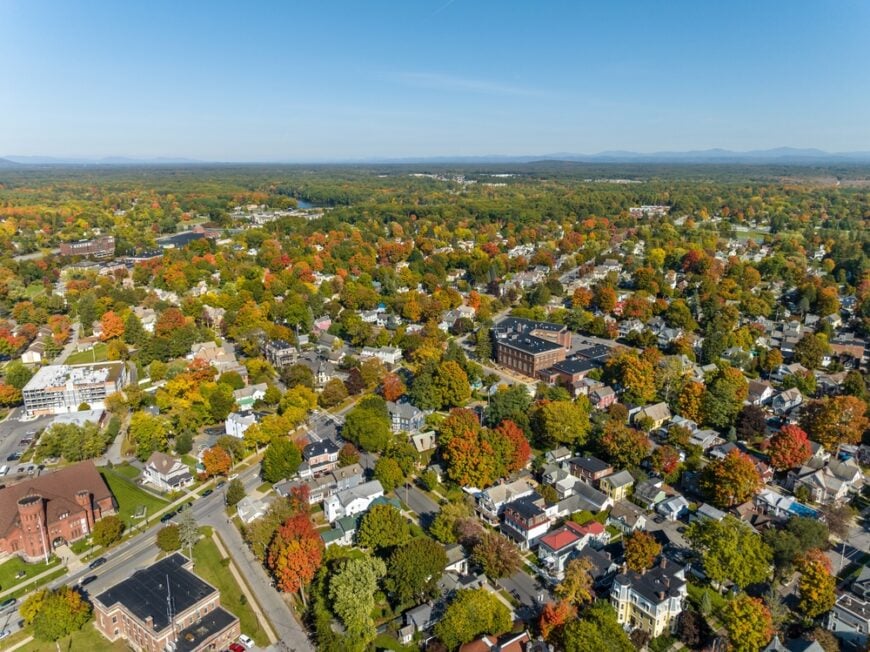
Saratoga Springs flourishes on the reputation of healing mineral waters that still bubble from 19th-century pavilions dotted throughout the city’s parks. Horse racing adds equal glamour each summer when Saratoga Race Course opens its wrought-iron gates to thoroughbreds and straw-hat crowds sipping frozen lemonade.
Broadway’s brick blocks feature Italianate cornices, boutique hotels, and spas where visitors “take the waters” in marble bathhouses. Nearby Saratoga Battlefield, site of a crucial Revolutionary War victory, offers driving loops and ranger-led hikes across rolling meadows.
Evening brings jazz at Caffè Lena, America’s longest-running folk venue. A lesser-known delight is Yaddo Gardens, a Mediterranean-style oasis created by a writers’ retreat that often allows public strolls amid fountains and rose beds.
Saratoga Springs features 3-4 bedroom homes ranging from $600,000 to $900,000, appealing to those who appreciate rich history and cultural events.
Where is Saratoga Springs?
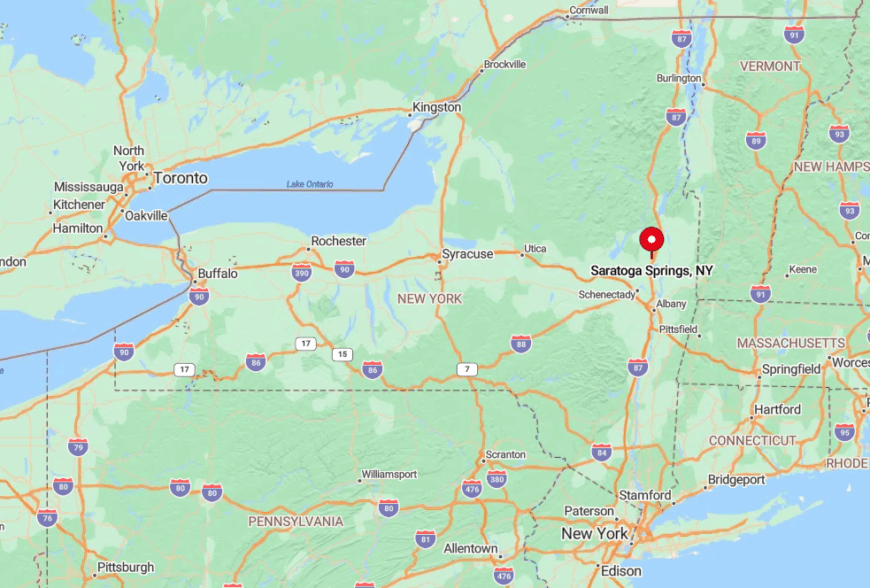
The city sits at the foothills of the Adirondacks, about 35 miles north of Albany along Interstate 87. A ridge shelters Saratoga Lake to the southeast, while the Kayaderosseras Range provides gentle terrain for cycling and cross-country skiing.
Amtrak’s Ethan Allen Express and Adirondack lines stop at the restored brick depot on West Avenue. Albany International Airport lies a half-hour drive south, making Saratoga an easy weekend escape for downstate residents.
3. Hudson: A Revival of Maritime History
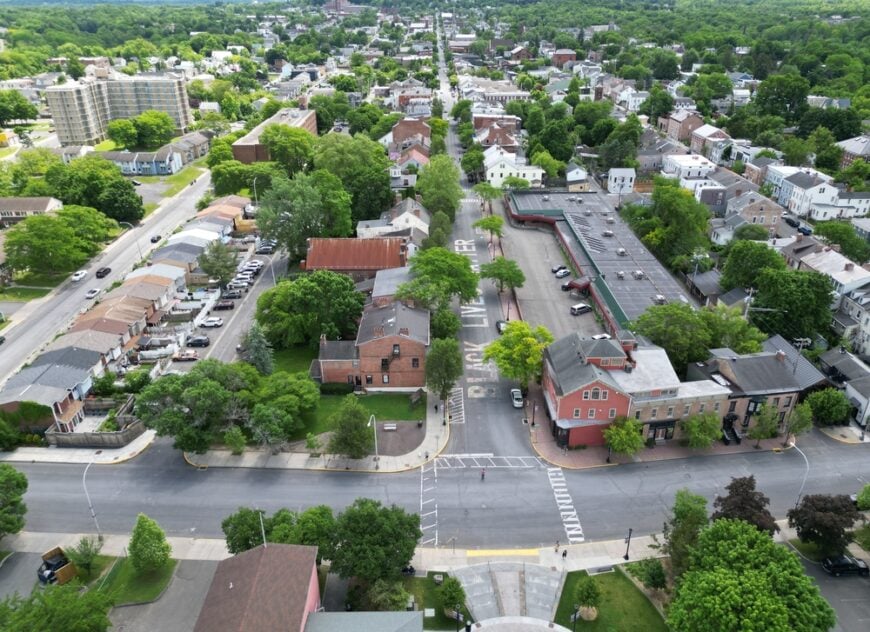
Once a bustling whaling port, Hudson reinvented itself through preservation and the arts, transforming derelict warehouses into lofts, galleries, and farm-to-table bistros along mile-long Warren Street.
Federal-style townhouses share blocks with Italianate banks turned antique showrooms, inviting hours of treasure hunting for mid-century lighting and ship salvage. Basilica Hudson, a reclaimed factory at the riverfront, hosts indie music festivals and climate-action conferences beneath beams that once bore whale oil.
Craft brewers occupy carriage houses, while food trucks park in alleys during the warm months, creating spontaneous courtyards ablaze with string lights. A hidden highlight is Hudson Athens Lighthouse, accessible via seasonal boat tours that reveal 1874 granite walls still guiding river traffic.
Scenic Rail-Bikes offer a quirky way to pedal along old freight tracks through wetlands alive with herons and bald eagles. Hudson offers 3-4 bedroom homes priced between $400,000 and $650,000, blending historic charm with a lively arts scene.
Where is Hudson?
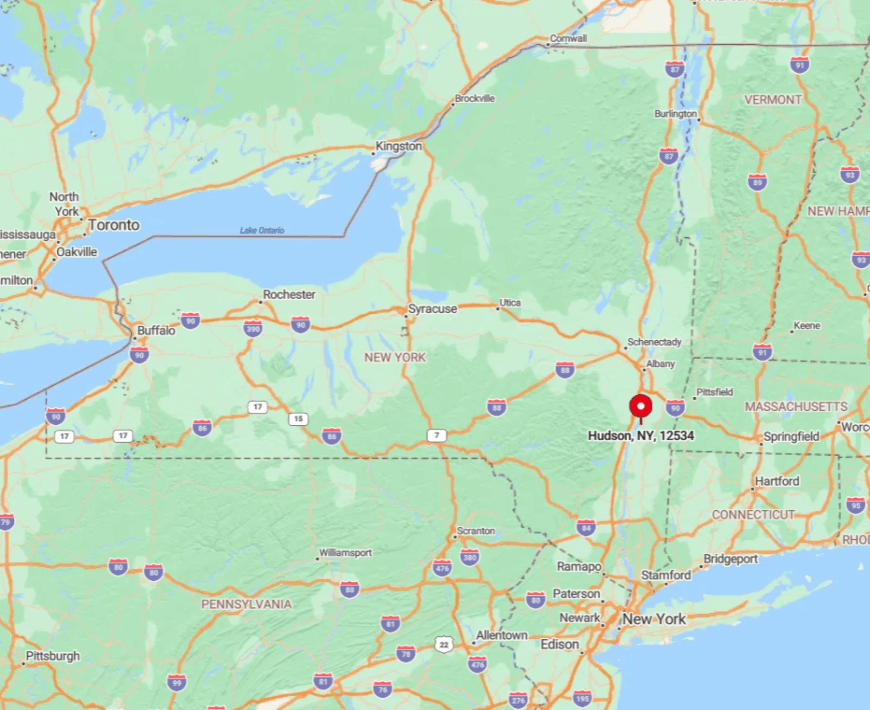
The city rests on the east bank of the Hudson River in Columbia County, framed by the Catskill Mountains rising across the water. Amtrak’s Empire Service and Ethan Allen Express provide direct rail access from New York City in just over two hours, depositing passengers steps from Front Street.
Drivers usually take the Rip Van Winkle Bridge off Route 9G, while cyclists arrive via the newly extended Empire State Trail. Hudson’s deep-water harbor, unusual this far upriver, once allowed ocean-going ships, underscoring its maritime lineage.
2. Cooperstown: Home of Baseball and Heritage
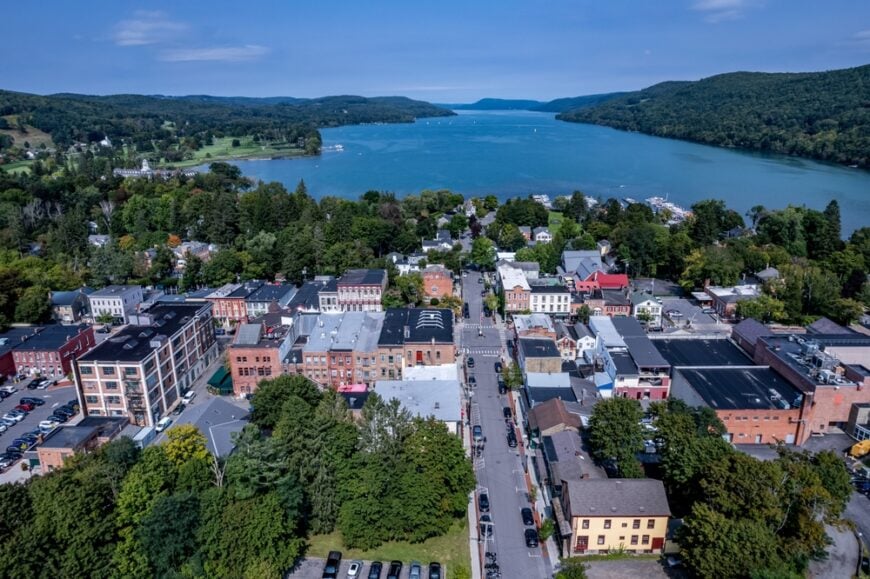
Cooperstown charms visitors with its picture-perfect Main Street leading to the storied National Baseball Hall of Fame, where brass plaques immortalize legends from Ruth to Rivera. Doubleday Field still hosts vintage ballgames, complete with wool uniforms and wooden bats cracking beneath summer skies.
Beyond baseball, the Farmers’ Museum recreates rural 1845 life with ox-drawn carts and a hand-powered carousel carved by local artisans, while Fenimore Art Museum overlooks Otsego Lake with folk art and Native American collections.
The Glimmerglass Festival stages opera in a lakefront pavilion where audience members picnic on rolling lawns. People like to rent bikes and follow the nine-mile Interpretive Loop featuring leather-leaf bogs and the birthplace site of author James Fenimore Cooper.
Evening finds brewpubs pouring hoppy ales named for pitching legends, perfect after a stroll along the tree-lined lakefront. Cooperstown features 3-4 bedroom homes ranging from $350,000 to $500,000, perfect for those seeking a small town with baseball history.
Where is Cooperstown?

Nestled at the southern tip of Otsego Lake in central New York’s Leatherstocking Region, Cooperstown lies about 70 miles west of Albany. The surrounding forested hills create a storybook setting that inspired the “Glimmerglass” nickname.
Drivers usually approach on scenic Route 28 or Route 80, winding past dairy farms and fieldstone fences. Trailways buses connect from Albany, and a summer trolley circulates among museums, parking lots, and the tranquil lakefront.
1. Sleepy Hollow: The Legend Lives On
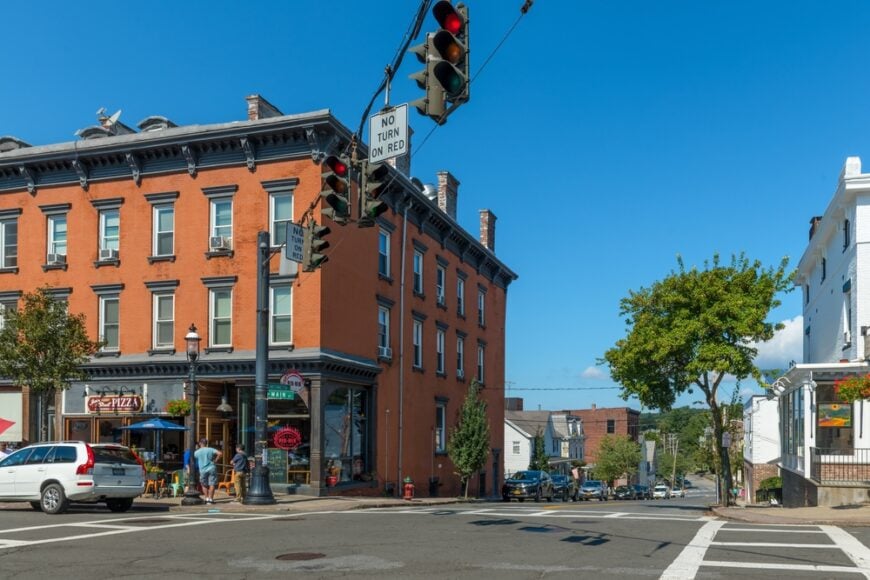
Sleepy Hollow captivates travelers with tales of the Headless Horseman thundering through moonlit lanes immortalized by Washington Irving. The Old Dutch Church and its burying ground, dating to 1685, invite twilight walks where moss-covered headstones lean like characters frozen mid-story.
Philipsburg Manor offers living-history demonstrations on a 300-year-old farm, while Rockefeller State Park Preserve presents carriage roads through woodlands that once formed a Gilded Age estate.
Tourists flock in October for horse-drawn hayrides and dramatic readings inside the candle-lit cemetery, but quiet winter mornings reveal frost-tipped reeds along the Pocantico River and hardly another soul in sight. Stop into the historical society to view a rare handwritten letter from Irving himself.
Local bakeries even craft “headless” gingerbread riders each Halloween, a sweet souvenir of America’s favorite ghost tale. Sleepy Hollow has 3-4 bedroom homes priced between $550,000 and $800,000, ideal for buyers fascinated by its legendary past.
Where is Sleepy Hollow?
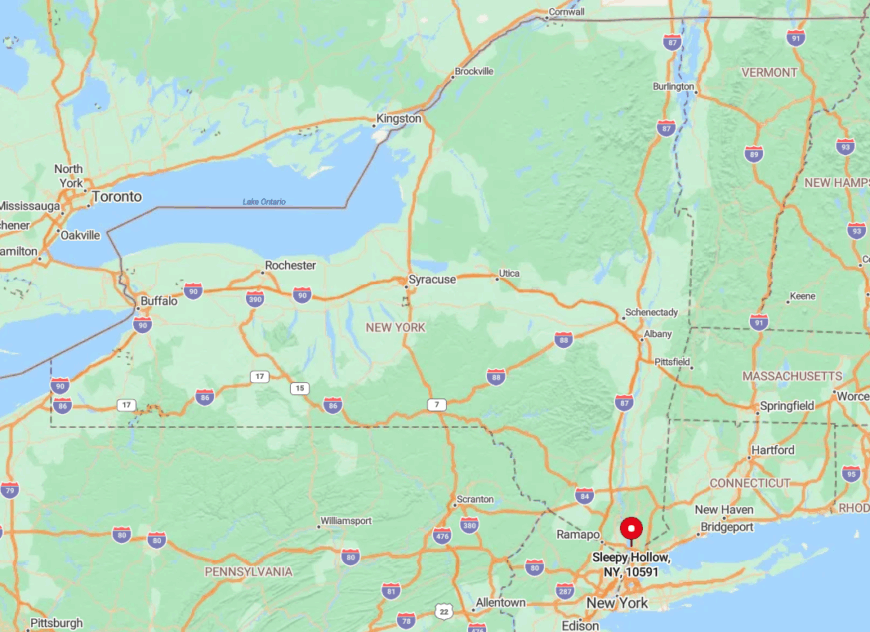
The village sits on the Hudson River’s eastern shore in Westchester County, directly north of Tarrytown and roughly 30 miles from Manhattan. Rolling hills and dense hardwood forests still resemble the “sequestered glen” Irving described two centuries ago.
Metro-North trains from Grand Central stop at Philipse Manor station, a leisurely riverside walk from the historic district. Drivers follow the Taconic Parkway or U.S. Route 9, while cyclists often join the Old Croton Aqueduct Trail that threads quietly through village backyards and relics of early infrastructure.


